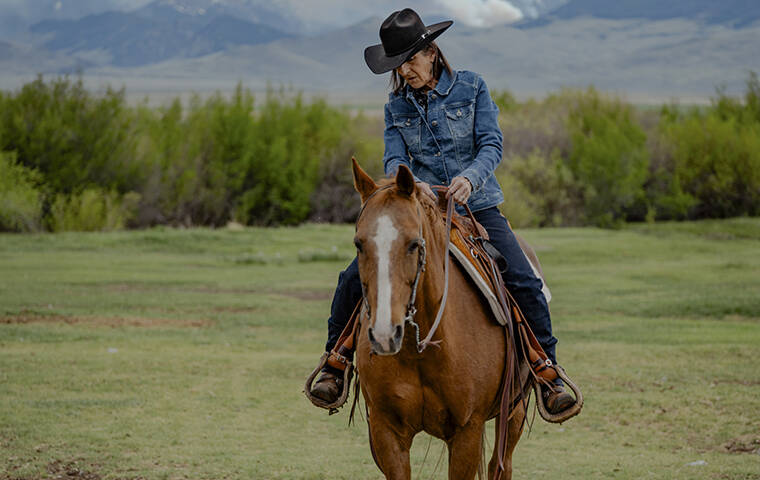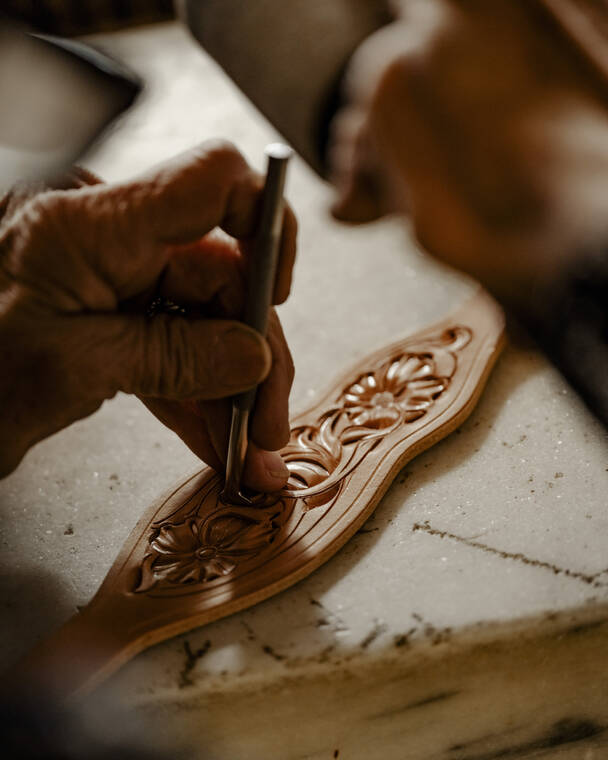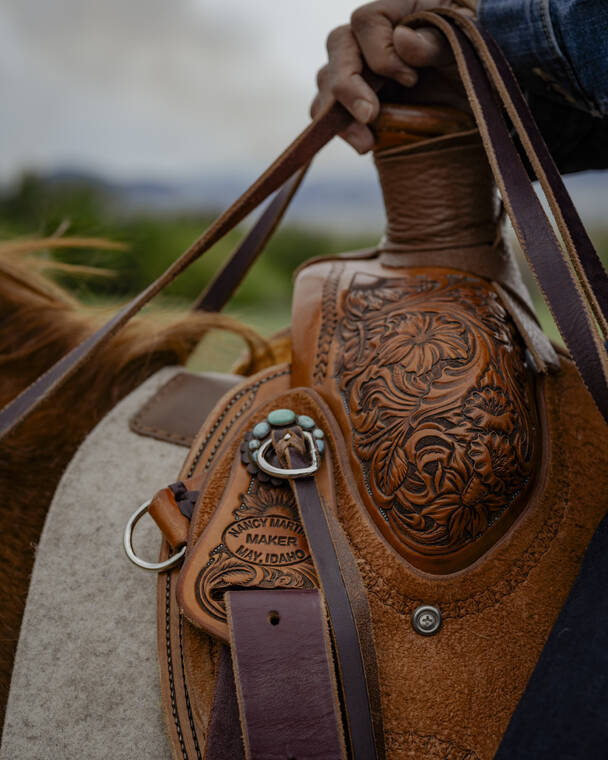Cowgirl’s artisty is practical, enduring

NEW YORK TIMES
Saddlemaker Nancy Martiny is known for the intricate floral patterns that she carves onto a saddle’s swell and skirt. Martiny’s saddles, which she creates in her home workshop in Idaho, are meant to be ridden by working cowboys and cowgirls like herself.

NEW YORK TIMES
Saddlemaker Nancy Martiny is known for the intricate floral patterns that she carves onto a saddle’s swell and skirt. Martiny’s saddles, which she creates in her home workshop in Idaho, are meant to be ridden by working cowboys and cowgirls like herself.

NEW YORK TIMES
Saddlemaker Nancy Martiny is known for the intricate floral patterns that she carves onto a saddle’s swell and skirt. Martiny’s saddles, which she creates in her home workshop in Idaho, are meant to be ridden by working cowboys and cowgirls like herself.



Nancy Martiny didn’t know what she was doing when she made her first saddle.
It took her almost a year of stolen afternoons — between ranching, rodeoing and raising three children in rural Idaho — to complete it.
But because she did it under the guidance of a renowned saddlemaker, Dale Harwood, that first saddle turned out well. And because she was a real-life cowgirl who rode in that saddle while producing rodeos and working cattle, people trusted her — even though she was a woman in a field dominated by men.
“I was out amongst my customers,” Martiny said. “And that gives a man the confidence that I know what I’m talking about.” The orders started rolling in. And for more than three decades, they haven’t stopped.
Martiny, 65, wears pearl-snap shirts tucked into jeans, and speaks deliberately, with dashes of dry humor. She lives with her rancher husband in a log cabin in May, Idaho, in a seemingly endless valley surrounded by bulky green mountains that resemble sleeping dinosaurs.
It was here, in her home workshop, that Martiny recently made her 500th saddle. The wait time for a new “Nancy saddle” is now around six years, despite the fact that she closed her order book in 2022. (Last year, she made a saddle for a customer who put his name on the list nearly two decades ago.)
Don't miss out on what's happening!
Stay in touch with breaking news, as it happens, conveniently in your email inbox. It's FREE!
When Martiny first started out, she charged around $1,100 for a saddle. Now, her base price is $5,000 — but that’s “one of those theoretical prices,” she said, because no one comes to her for a basic saddle.
The most ornate saddle she ever made cost $15,000.
Martiny has served as a master artist for Art of the Cowgirl, an annual event teaching Western trades. She has also been recognized by Brad Little, the governor of Idaho, for excellence in folk and traditional arts.
But as a woman, some people still assume that Martiny’s husband does the work — and that she merely helps. “That jabs at you a little,” she said. Especially because, Martiny added, her husband knows better than to enter her workshop.
Martiny fell in love with leather at the age of 15, when her father taught her to make a belt. She didn’t learn to make saddles until she was 30. That’s when Harwood, a famous saddlemaker, took her under his wing.
Whenever she had a few hours to spare, Martiny made the hourlong drive, past sagebrush steppes and potato fields, to Harwood’s shop, filling a notebook with his instructions. “It was pretty overwhelming,” she said. “Dale always said it takes you 50 saddles to figure out and remember the process. I figured it took me a hundred.”
On a recent Saturday, Martiny showed off her own workshop. The walls were covered in photos of her children, stepchildren and grandchildren, often atop horses or bulls. Tools and hides were scattered on every surface, as were products in various stages of completion: purses, belts, halters and, of course, saddles. A single saddle requires the hide of an entire cow.
Sitting on a stool, Martiny sketched flowers onto a piece of paper. (She is known for using intricate floral patterns.) She traced outlines onto the leather with a swivel knife: lightly at first and then harder. She was as meticulous as the leather was unforgiving. “This used to be living, but it will not heal up,” she quipped. So any mistakes are “pretty hard to erase.”
Given that Martiny spends about an hour carving each 4-inch patch, she has not gotten rich off her craft. For her, the tradition has always mattered more than the money: “A piece of carved leather,” she said, “symbolizes the West: cowboys, cattle, horses, ranching.”
Martiny has never made a saddle for a show horse. Her pieces are meant to be ridden by working cowboys and cowgirls like herself. By focusing on function, Martiny has been able to carve out a name in an industry that few women enter.
Ultimately, Martiny believes that being a female saddlemaker — producing no more than 26 saddles a year, since she also spends time cooking and keeping house; relying on skills and tools, rather than strength — has given her an advantage. Compared with those of male saddlemakers her age, some of whom churn out a saddle a week, she said, her hands are holding up well. And she will keep making saddles as long as that stays true.
“My first saddle, it’s going to be here long after I’m gone,” she said. “And I like that. Not that I need my name to be carried on — just that the thing I built was sustainable. It wasn’t something that got used once and thrown away.”
This article originally appeared in The New York Times Opens in a new tab.
© 2024 The New York Times Company



